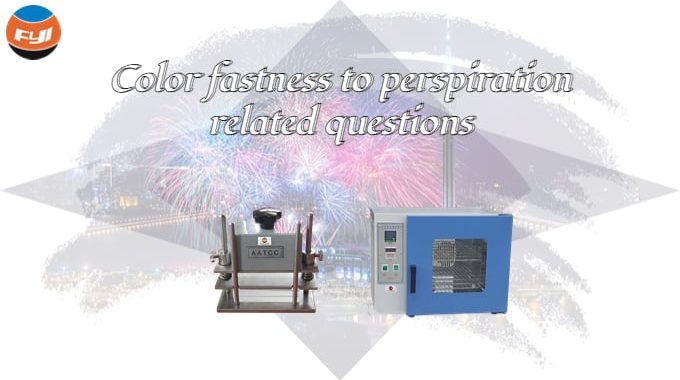
Color Fastness to Perspiration Related Questions
Contents
What are the types of fastness?
Color fastness, refers to the resistance of textile color to various effects during processing and use. The color fastness test of textiles is a routine item in the intrinsic quality test of textiles. Generally, the color fastness grade is evaluated according to the discoloration of the sample and the stain of the undyed lining fabric. Color fastness is an important test item for the quality of textile and garment products. According to the different application environment of textile and apparel fabrics in the actual production and application process, the color fastness of textile and apparel fabrics have different requirements.
With the improvement of people’s living standards, textile and clothing should not only meet people’s needs for heat preservation, but also meet people’s needs for functional and personalized. Colorful and colorful textile clothing to meet people’s needs for individuality, but also to meet people’s special need for beauty. Although the changing color of clothing increases the variety of clothing styles to a certain extent, it also brings certain difficulties to the quality control of clothing products. How to reduce the dye in storage, washing, maintenance of the color dip, fading and other conditions, is the garment production enterprises must face the quality problem. In order to standardize the quality of textile and garment products produced and sold, the national standards have made clear requirements on the color fastness of textile and garment.
There are dozens of kinds of color fastness. Common color fastness include color fastness to friction, soap, sweat stains, water, saliva, light, light and sweat, etc., which are selected and evaluated mainly according to the use of the final product. Among them, color fastness to dry friction, color fastness to water, color fastness to sweat stains and color fastness to saliva (only for baby products) are the items required by the basic safety technical specifications of textiles.
What is perspiration fastness?
There are millions of active sweat glands on the human skin. The forehead, armpits, front chest, back and palms sweat more. Therefore, summer often wear such as shirts, T-shirts and other clothes will appear in these parts of the serious fading phenomenon.
As we all know, the composition of human sweat is complex, among which the main component is salt, different from person to person, sweat has acid, also has alkaline. Short contact between textile and sweat may have little effect on its color fastness, but long time close to the skin and sweat contact, will have a greater impact on some dyes. Clothing with unqualified dyeing fastness is easy to transfer dyes from textiles to human skin through sweat, and dye molecules and heavy metal ions may be absorbed by human body through the skin and harm health.
The color fastness to perspiration refers to the degree of color change caused by the colored fabric soaked in acid or alkaline solution and a variety of fiber cloth for a certain time, and then treated under certain conditions, and the degree of color stain caused by a variety of fiber cloth.
What is perspiration Tester?
YG631 Series Perspiration Color Fastness Tester
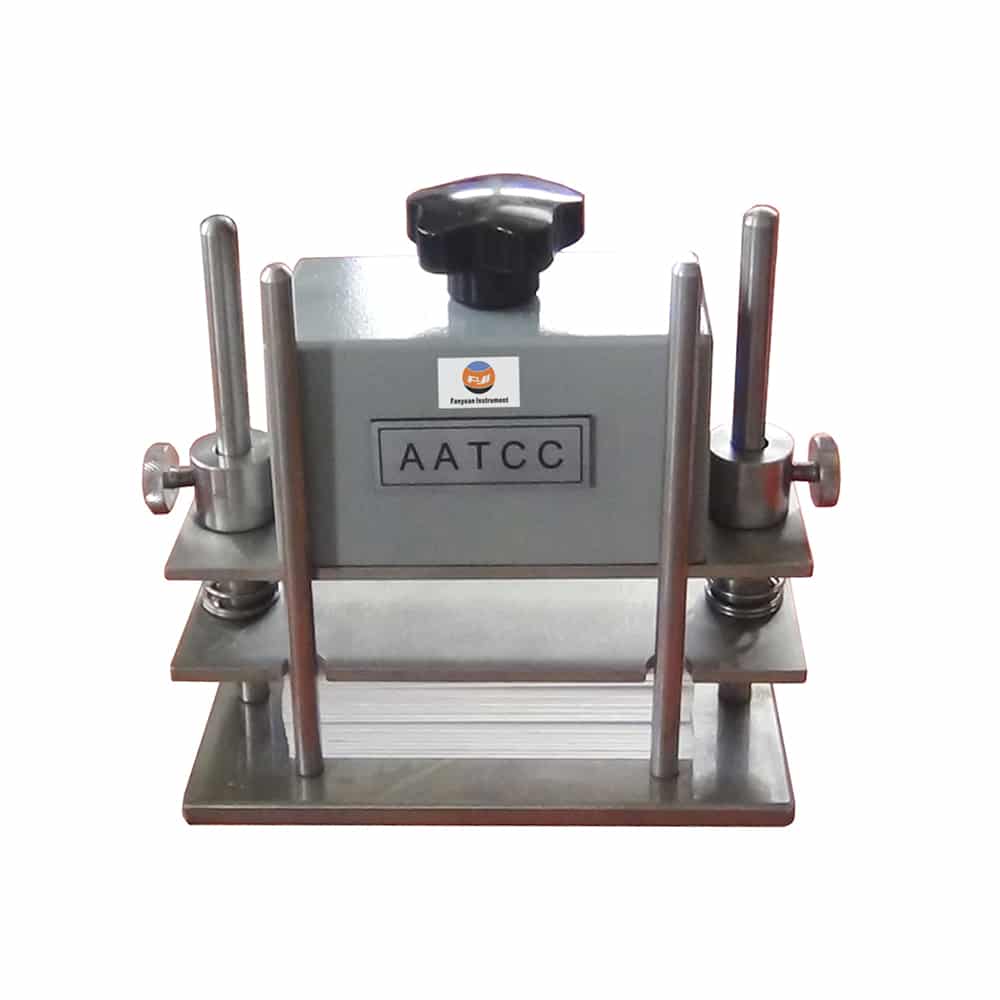
Application:
YG631 Series Perspiration Color Fastness Tester is used to determine color fastness to water, perspiration, saliva and seawater of textiles.
Features:
- Special designed weight sets satisfy various requirements of ISO and or AATCC standards;
- Micro-computer with PID parameters controlling function,avoid temperature overshoot;
- Adopt advanced design of blast system,and the temperature fluctuation is low,Temperature uniformity is stable;
- Heater is controlled by contact less solid state relay, no noise, long service life;
- Oven temperature and time are pre-settable with temperature duly displayed;
- Digital timer with audible alarm when the preset time is over;
- The working chamber is made of 304 mirror-like stainless steel plate,effectively prevent acid and alkali corrosion;
- With two layers of stainless steel shelf, each layer can be placed two test frames,there are max. four test frames for each test,it surely saves energy and improve work efficiency;
- The door has a large size of double tempered glass observation window.
Related Standards:
ISO105 E01, E02, E04, AATCC15, 106, 107, 165, GB/T 3922, 5713, 5714, JIS L0846, L0847, L0848, etc.
Parameters:
| Model No. | YG631 |
| Weight set | 5kg |
| Resin plate area | 60×115mm |
| Dimensions | 210×100×160mm (L×W×H) |
| Net weight | 12kg |
Y902 Oven for Perspiration Color Fastness Test
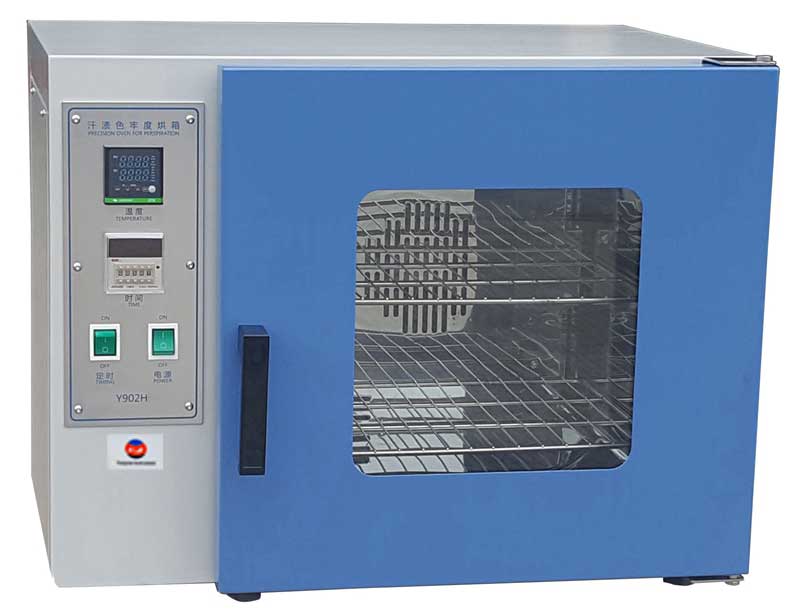
Application:
Y902 Oven for Perspiration Color Fastness Test is used with YG631 series perspiration color fastness tester together to carry out the color fastness to perspiration test.
Parameters:
| Temperature range | RT~99oC, LED display |
| Temperature accuracy | ±1oC |
| Time range | 0~99h/99min/99s |
| Capacity | 28L |
| Working chamber dimensions | 340×260×320mm |
| Power supply | AC220V 50Hz |
What is perspiration test in textile?
The textile sample is combined with the specified lining fabric and placed in two different test liquid containing histidine. After separate treatment, the test liquid is removed and placed in the test device between two plates with the specified pressure. Then the sample and the lining fabric are dried separately.
The discoloration of the sample and the stain of the lining fabric were evaluated with a grey sample card.How do you use as we all know, the composition of human sweat is complex, among which the main component is salt, different from person to person, sweat has acid, also has alkaline. Short contact between textile and sweat may have little effect on its color fastness, but long time close to the skin and sweat contact, will have a greater impact on some dyes. Clothing with unqualified dyeing fastness is easy to transfer dyes from textiles to human skin through sweat, and dye molecules and heavy metal ions may be absorbed by human body through the skin and harm health.
For the health of consumers, the national compulsory standard GB 18401-2010 “National Technical Specification for Basic Safety of Textile Products” requires that the rating of Class A products (infant textile products) with color fastness to sweat stains (acid and alkali) should be greater than or equal to 3-4; The requirements of Class B products (products directly in contact with skin) and Class C products (products not directly in contact with skin) are greater than or equal to level 3 (the color fastness of perspiration is divided into 1 to 5, the greater the value, the better the color fastness).
The color fastness to perspiration is to reflect the discoloration of the textile and the coloring of the lining fabric in different test liquid containing histidine under the combined action of pressure and temperature. Grey card was used to evaluate the discoloration of the sample and the stain of the lining fabric. The results were divided into 5 grades, 5 grades good and 1 grades poor.
How to use a Perspirometer?
Put the composite specimen between the plastic boards at first, and then put it between the base frame and spring pressure rack. Put the hammer that the test standard required on the spring pressure board, at last tighten the seat screw, and put them all into the constant temperature oven (Color Fastness to Perspiration Oven).
The specific operations refer to the test standards ISO 105-E01/E02/E04-1994, AATCC 15/106/107-2002 etc.
How can l improve my color fastness to perspiration?
The main way to improve the color fastness to sweat of fabrics is to choose dyes reasonably, especially dyes with high color fixation rate and good stability. Reasonable formulation and control of dyeing process, strengthening of color fixation conditions and forming stable covalent bonds can make dyes fully fixed. For example, when the reactivity is poor, the catalyst can be selected, or the appropriate color fixing agent can be selected, or the color fixing can be adopted at a higher temperature.
Comments are closed.

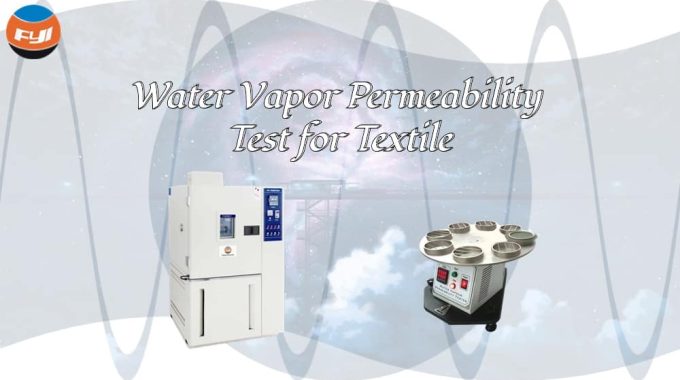
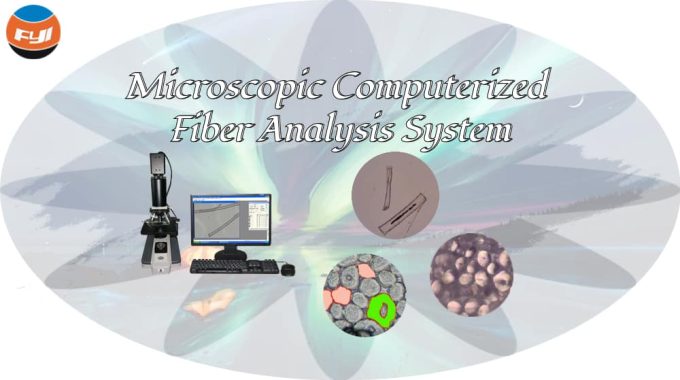
excellent article I’m going to bookmark this article, and many thanks to the author for sharing this information with us.
This is hands down one of the best blogs I’ve ever come across. Your writing is top-notch.
About halfway through the article, I found myself completely immersed in the author’s unique perspective and insightful analysis.